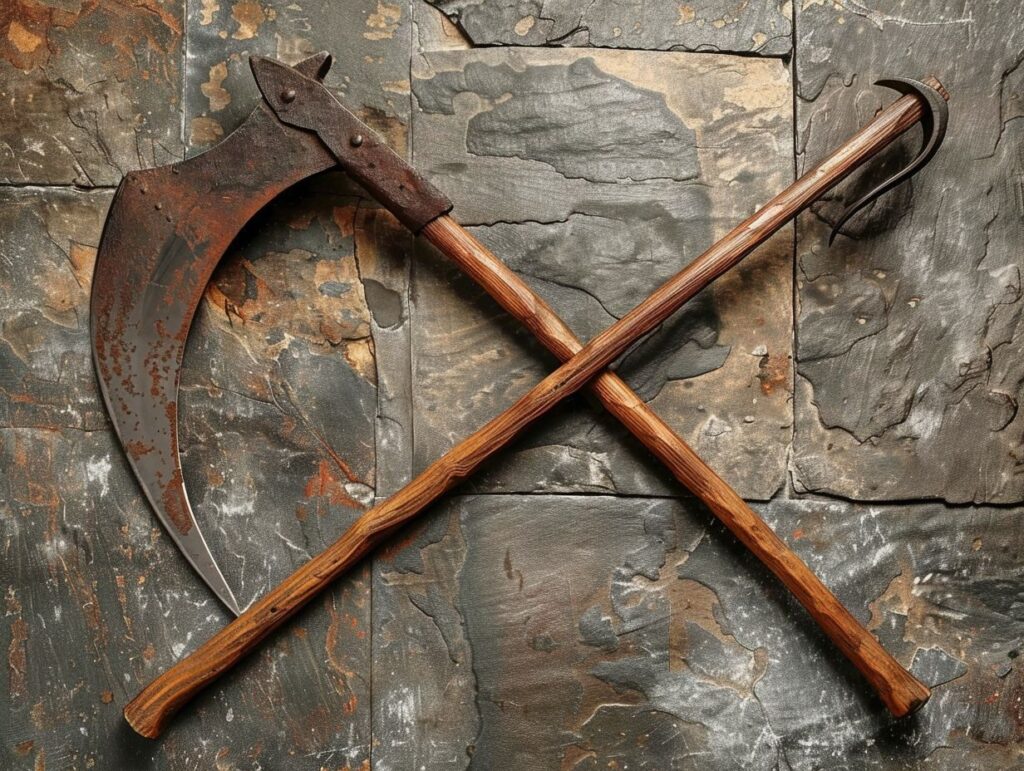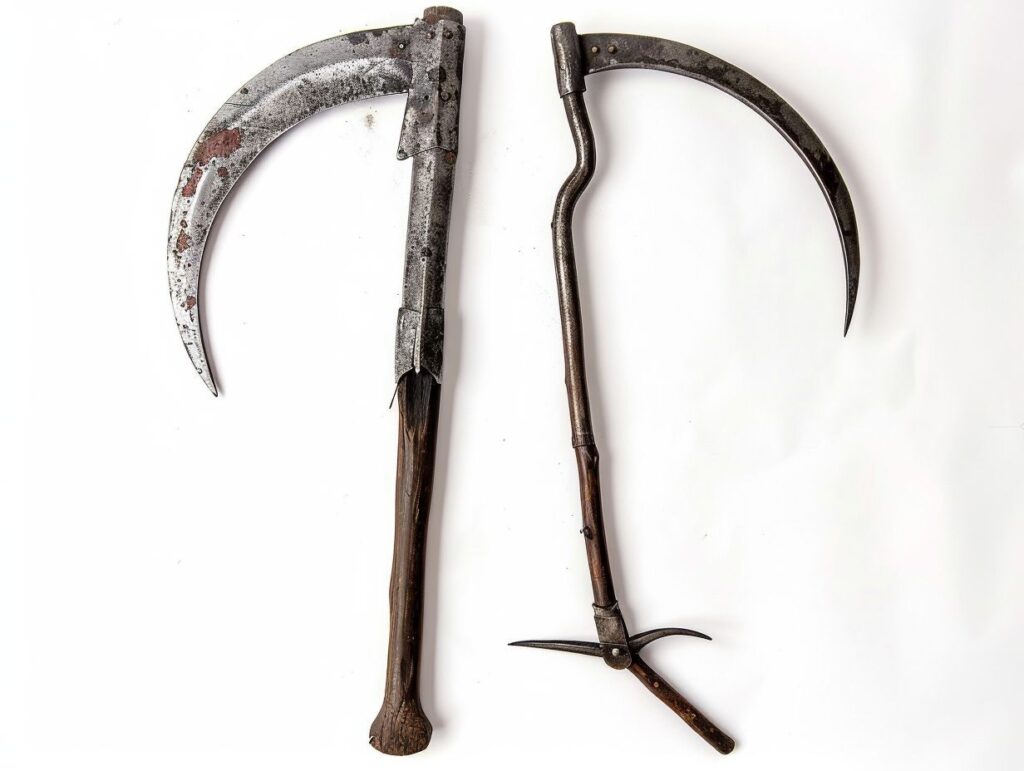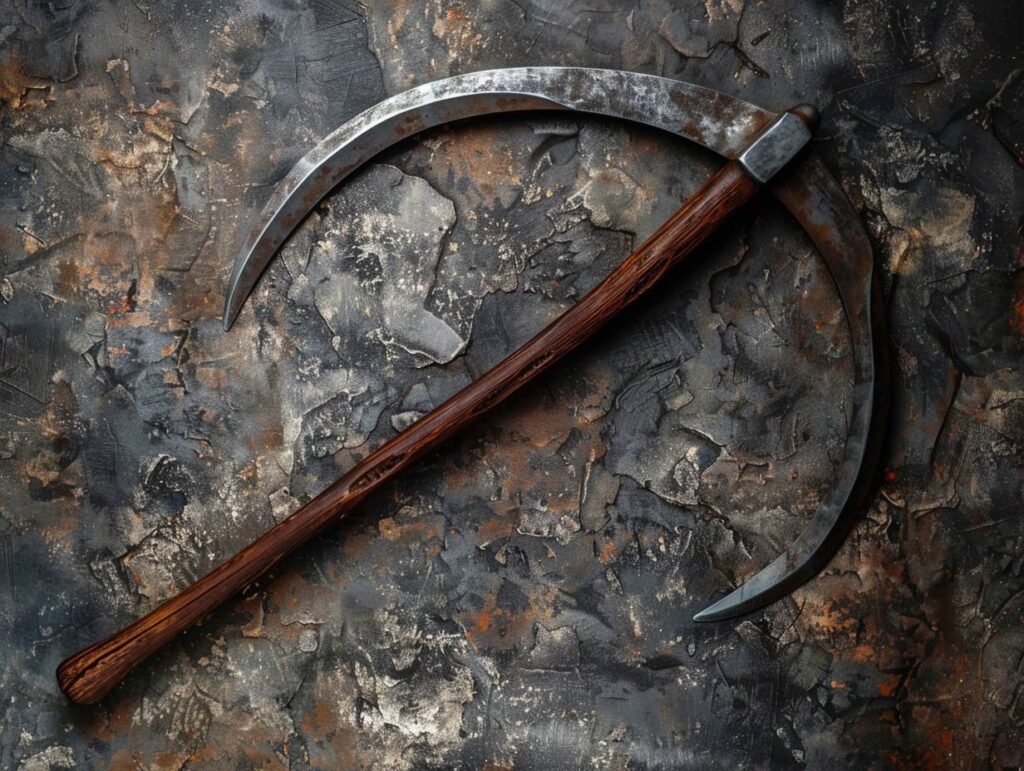Key Takeaways
- Scythes and sickles have a long history and were both used as agricultural tools.
- Both tools have a unique design and function that make them suitable for different tasks.
- The decision between using a scythe or a sickle depends on personal preference and the intended use.
History of Scythes and Sickles
The history of scythes and sickles dates back centuries, with these tools being vital for agriculture and harvesting.
Both the scythe and sickle have played crucial roles in the evolution of farming practices and the advancement of civilizations.
You see, the scythe is all about that long, curving blade attached to a wooden handle, making it perfect for efficiently reaping grain crops like wheat and barley.
The sickle, a smaller tool held in your hand with a curved blade, is great for more delicate tasks such as harvesting rice or cutting grass.
When these tools were introduced, they really revolutionized early agricultural societies.
People were able to crank up their productivity, resulting in surplus food production and the rise of more complex civilizations.
It’s like these humble tools paved the way for big things to happen in farming and society as a whole.
Origin of Scythes
The origin of scythes can be traced back to ancient times, with early civilizations recognizing the value of this tool for efficient harvesting.
The scythe’s evolution showcases the ingenuity of our ancestors in developing tools that revolutionized agricultural practices.
Early scythes were crafted from basic materials like wood for the handle and a sharpened blade made of stone or metal.
These primitive designs marked the beginning of a significant shift in farming efficiency, allowing farmers to cut through crops with greater ease and precision.
Over time, advancements in metallurgy led to the production of more durable and sharp scythe blades, further enhancing their functionality.
The widespread adoption of scythes across various cultures accelerated the growth of agriculture by streamlining the process of harvesting crops.
Origin of Sickles
You’ve probably heard that sickles have an interesting backstory dating all the way back to ancient agricultural societies.
Back in the day, they were the go-to tool for harvesting crops like wheat and barley.
The evolution of sickles really shows how important it is to collect crops efficiently and how technology has shaped farming methods over time.
As farming techniques got fancier, sickles went through all sorts of design changes to match specific crops and regional requirements.
In some cultures, sickles were more than just tools – they were symbols of prosperity and abundance, used in ceremonies and rituals.
The roots of sickles can be traced back to Mesopotamia and Ancient Egypt, where they were essential for the growth of organized agriculture.
The switch from stone sickles to metal ones was a game-changer, bringing in a whole new level of efficiency and durability for more precise and effective harvesting.
Design and Function of Scythes and Sickles

In terms of scythes and sickles, their design and function are critical for getting the job done right in the field.
To optimize their performance, you need to understand what makes these tools tick.
Let’s talk about blade shapes – they’re key to how well a scythe or sickle works.
The curved blade of a sickle is perfect for delicately snipping smaller plants or grass, while the long, straight blade of a scythe is all about sweeping through big crops like a boss.
Now, let’s move on to handle structures.
Scythes usually rock longer handles for that extra reach, while sickles keep it short and sweet for precise, up-close cutting.
And don’t forget about ergonomics – those grips are there to keep you comfy during those long hours in the field, making sure you work efficiently and don’t end up feeling like you’ve been arm-wrestling all day.
Shape and Size
In terms of scythes and sickles, their shape and size are all about catering to their specific purposes.
The variations in blade curvature and handle length really affect how well they get the job done.
These design details are key to how efficient these agricultural tools are.
Let’s break it down. The curved blade of a scythe is perfect for mowing down tall grasses or crops in one smooth swing thanks to its wide arc.
The smaller sickle is all about precision cutting, making it ideal for harvesting smaller crops like herbs or flowers.
Now, let’s talk about handles. The length of the handle on these tools is a game-changer.
Longer handles give you more leverage and control, perfect for reaching those taller plants.
Shorter handles are great for detailed cutting in tight spots.
So, depending on what you’re working with, the handle length can make a big difference in how well you can handle your scythe or sickle.
Blade and Handle
In terms of scythes and sickles, the blade and handle are key players in how well the tools cut and how comfy they are to use.
The quality of the blade and the design of the handle really make a difference in how these farm tools perform.
The blade isn’t just about staying sharp for clean cuts—it also affects how smoothly the scythe or sickle can slice through plants.
And don’t underestimate the handle material either; it can make a big difference in how well you can grip and control the tool, making your cutting more precise and efficient.
Getting the blade and handle in sync is crucial for a smooth and comfortable cutting experience.
It’s all about finding that sweet spot where you can work efficiently for longer without feeling the strain or discomfort.
Uses of Scythes and Sickles
In your agricultural and landscaping endeavors, you’ll find scythes and sickles to be incredibly versatile tools.
Whether you’re out in the fields harvesting crops or working on shaping shrubs in your garden, these tools are incredibly efficient.
A scythe, with its long curved blade, is ideal for quickly and effectively mowing down large areas of grass or wheat with broad sweeping motions.
The sickle, sporting a short, sharp blade, is perfect for more intricate tasks like pruning branches or delicately gathering herbs and flowers.
Both the scythe and the sickle are known for their precision and user-friendliness, allowing farmers and gardeners alike to achieve clean cuts and maintain the visual appeal of their landscapes.
Similarities between Scythes and Sickles
You can see that scythes and sickles have a lot in common in how they’re designed and used, showing their shared roots in agriculture.
Recognizing these similarities can give you a better understanding of the basic principles behind these traditional tools.
When you take a closer look, both the scythe and sickle have a long handle and a curved metal blade that’s perfect for cutting through crops like wheat or barley with ease.
The curved blade lets you slice smoothly while harvesting, making the job efficient and productive.
Throughout history, farmers in different areas have relied on both tools to tend to their fields and gather crops at harvest time.
It just goes to show how these agricultural tools have stood the test of time.
Differences between Scythes and Sickles

In terms of scythes and sickles, they may seem similar at first glance, but they each have their own unique features that make them perfect for different agricultural tasks.
These differences is key when choosing the right tool for the job.
So, picture this: a scythe usually has a long, curved blade attached to a lengthy handle.
It’s great for those big, sweeping motions when you’re cutting through thick grass or grain.
Now, flip the script. A sickle rocks a short, hook-shaped blade with a small handle.
This setup is all about precise cutting of small plants or crops that are closer to the ground.
Oh, and don’t forget about handle length. Scythes go big with longer handles, giving you more reach and power.
Sickles keep it short and sweet, with handles that are perfect for those cramped spaces where control is key.
Primary Use
When you’re talking scythes and sickles, it all comes down to their design and blade features.
Scythes are the champs when it comes to cutting big grassy areas and crops, while sickles are your go-to for picking grains and veggies with finesse.
Scythes are like the heavy-duty cutters of the farming world, slicing through thick plants like a hot knife through butter.
They’re perfect for big farms looking to clear fields in a jiffy.
Sickles are all about that precision. They give you the control you need to harvest delicate crops like rice and wheat without causing a ruckus.
Farmers swear by sickles when it comes to gathering grain, making sure they get every last bit without any waste.
Knowing the strengths of scythes and sickles helps agricultural workers pick the right tool for the job and boost their productivity all around.
Blade Shape
In terms of scythes and sickles, their blade shapes are like their unique personalities.
Scythes rock those long, curved blades, perfect for wide, sweeping cuts, while sickles sport shorter, straight blades, ideal for precise slices on individual stalks or plants.
These traditional farming tools are all about their blade shapes, which totally dictate how you should use them.
Scythes, with their elegantly curved and lengthy blades, are all about making easy work of cutting through tons of vegetation in fields.
They’re your go-to for harvesting grains or mowing grass for hay. On the flip side, sickles with their shorter, straight blades are all about the details.
They’re your MVPs for carefully gathering specific crops or trimming delicate plants with pinpoint accuracy and style.
Handle Length
In terms of scythes and sickles, the handle length varies to suit different cutting techniques and user preferences.
Scythes usually have longer handles for that extra reach and leverage, while sickles opt for shorter handles to ensure precise control when harvesting.
The length of the handle is key when it comes to how comfy and efficient these traditional tools are to use.
Longer handles on scythes let you stand upright while cutting, easing the strain on your back and shoulders.
Plus, that added length gives you more oomph to swing the blade through thick vegetation.
Sickles with their shorter handles offer better control and maneuverability for navigating tight spaces or harvesting delicate crops.
The handle design directly affects how precise your cuts are and how easy it is to use the scythe or sickle.
Efficiency and Effectiveness
When using scythes and sickles, the key to their efficiency and effectiveness lies in factors like blade sharpness, handle ergonomics, and your own skill level.
To get the most out of these tools, you need to understand how they work and what they need to stay in top shape.
Sharpness is crucial for how well your scythe or sickle slices through crops or grass.
A sharp blade makes cutting smoother and easier, reducing the effort you have to put in.
The handle’s design is important for your comfort and control while using these tools.
It can make a big difference in how efficient you are during long periods of use.
Skilled users can really take advantage of scythes’ and sickles’ features to maximize their cutting abilities, showing how your expertise and the tool’s design can work together seamlessly.
Which is Better: Scythe or Sickle?

In terms of deciding between a scythe and a sickle, it all boils down to your personal preferences, the specific agricultural jobs at hand, and what outcomes you’re aiming for.
Both tools come with their own set of perks and are better suited for different cutting tasks.
If you’ve got a large area of grass or crops to tackle, a scythe might be your best bet.
Its long handle and curved blade design make it perfect for slicing through extensive fields with ease.
If you need precision for tasks like harvesting specific plants or trimming delicate areas, a sickle could be the tool for you.
The scythe’s broad sweeping motion is great for clearing out vast stretches of land, which makes it a top choice for big cultivation projects.
Meanwhile, the sickle’s compact size and sharp hook are ideal for those detailed, close-up jobs in tight spaces – like harvesting herbs or flowers.
Factors to Consider
When you’re faced with the decision of choosing between a scythe and a sickle, there are a few things you need to keep in mind.
Think about the types of crops you’ll be harvesting, the size of your agricultural area, and how comfortable you are using each tool.
Considering these factors is key to picking the right cutting tool for the job.
Your choice between a scythe or a sickle really depends on the crops you’re dealing with.
If you’ve got larger crops like grasses or grains, a scythe with its long blade might be your best bet for efficient cutting.
If you’re working with more delicate plants or need to make precise cuts in tight spaces, a sickle with its smaller cutting edge could be the way to go.
Don’t forget about the size of your field – a scythe’s sweeping motion needs more room to maneuver compared to the precise cutting action of a sickle.
And your own skill level with each tool matters too.
Using a scythe requires a different technique and strength than a sickle, which can impact how smoothly and effectively you harvest your crops.
Personal Preference
In terms of choosing between a scythe and a sickle, your personal preference is key.
Your comfort, how easy it is to handle, and your cutting style all play a part in making the right choice for you.
If you’re all about that sweeping cutting action, you might lean towards the scythe with its longer handle and wider range of motion.
But if you’re into precision and agility, the sickle’s compact size and lighter weight could be more your speed.
Don’t forget about ergonomics! Some folks swear by the curved handle of the sickle for long jobs, while others dig the straight handle of the scythe for that extra leverage and control.
It’s all about what feels right for you when it’s time to tackle those cutting tasks.
Intended Use
When you’re deciding between a scythe or sickle, think about what you’re going to use it for.
Scythes are perfect for big jobs, like cutting through large fields or meadows quickly and efficiently.
The long blade and sweeping motion make it a breeze to clear out big areas of grass or crops.
But if you need to be super precise, like when harvesting herbs or delicate crops, a sickle is the way to go. Its small size and sharp blade let you make careful, targeted cuts without any fuss.
Matching the tool to the task is key for getting the best results. Whether you’re tackling a big job or need to work with precision, picking the right tool will boost your productivity and give you top-notch agricultural outcomes.
Frequently Asked Questions
What is the difference between a scythe and a sickle?
A scythe is a long, curved blade attached to a long handle, while a sickle is a short, curved blade attached to a short handle.
Which tool is better for cutting crops, a scythe or a sickle?
This depends on the type of crop and the size of the area. A scythe is better for cutting large areas of tall grass or grain, while a sickle is better for smaller areas or delicate crops.
Can a sickle be used as a substitute for a scythe?
Yes, a sickle can be used to cut crops in place of a scythe, but it may take longer and require more effort due to its smaller size.
What is the history behind the use of scythes and sickles?
Both tools have a long history in agriculture, with evidence of their use dating back to ancient civilizations. Scythes were commonly used in Europe, while sickles were more popular in Asia and Africa.
Do scythes and sickles have any other uses besides cutting crops?
Yes, both tools have been used for various purposes such as cutting grass, clearing brush, and even in some traditional martial arts practices.
Which tool is easier to maintain, a scythe or a sickle?
Generally, a sickle is easier to maintain as it has a smaller blade and requires less sharpening. However, both tools should be regularly maintained to ensure proper function and safety.
